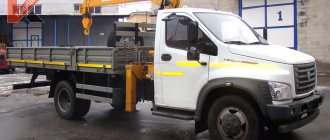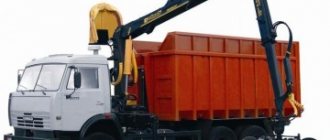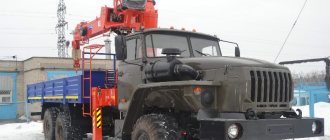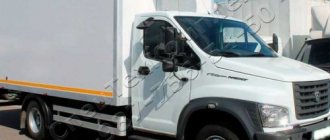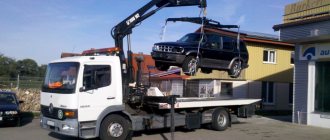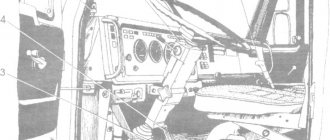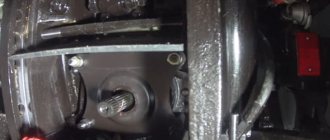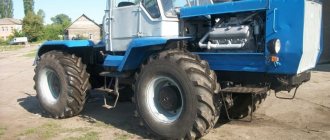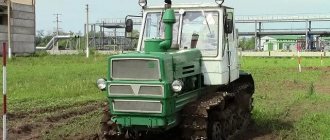The crane installation is controlled using a lever system.
Each lever has its own “task”:
- Raising and lowering the CMU boom.
- Raising and lowering the load hook.
- Extension and retraction of boom sections.
- Rotation of a column around its axis.
- Extension and retraction of outriggers.
Where are the crane control levers located that allow the driver to perform loading and unloading operations? There are only two options for their location: upper and lower.
Top manipulator control
The very word “upper” leads the reader to the idea that the lever control system of the manipulator installation is at a height.
Absolutely right: the top control of the crane-manipulator is levers mounted at the top of the column. Almost all loader cranes have an upper operator station, complete with a chair (without a cabin) and control levers on the column.
The main advantage of this control system arrangement is a complete view of the loading area, which allows the operator to effectively “steer” the boom.
The upper control of the manipulator, as a rule, is duplicated by the lower system: the CMU with a control panel on the column is also equipped with levers at the bottom of the column, on the frame.
Why is it that manipulators with a cabin or a chair on a column are not so often found on city streets? The fact is that the top control of the manipulator is used mainly on heavy-duty CMUs and on cable manipulators.
Tips for working with a crane
on how to operate a crane-manipulator:
Working with cargo
The first rule is that if you do not know the mass of the load, for any reach length and boom inclination, lift only with a CYLINDER and in no case with a winch. If the hydraulics don’t work, you can use a winch to bend the boom. For example, on a 3-ton CMU, the winch can lift 6 tons, which will lead to a bent boom. Take the load at 90 degrees from the boom, that is, at the level of the paws.
In front of the load that you will lift, stand as close and perpendicular as possible....For the first time, throw one side, that is, artificially set the roll of the machine in the direction of lifting the load and, as the boom turns, level it with your paws (outriggers). Try not to let the load shake. And if you have some understanding of descriptive geometry, you will gradually understand the principles of working with an arrow. Example: with your arm bent you can lift 30 kg, but with your arm extended how much?
If possible, move the load from the lifting point to the loading point at a minimum distance from the floor level and above objects (which are best avoided). If this is an upward feed, then it would be better to tighten it with a cable, because it will be clear whether there is a roll or not.
If the cargo needs to be placed on the level of the second floor, and even in close proximity to the unloading point, it is not possible to drive up. How to find out how far a loaded boom can be extended and at what angle? — Make the angle and reach of the boom in advance, keeping the load close to the ground, and the boom should be rotated closer to 90 degrees from the axis of the machine. If the load is heavier for this position of the boom, then the machine will roll, the load will touch the ground and that’s it. Why is it 90 degrees - if the boom is on its side, you won’t turn it (the boom), but the machine will tip over, but since the load is near the ground, it will sway a little and that’s all (and that’s only under the condition of a load in excess of the norm).
About supreme skill
A Nissan (a competitor) is standing on the road and unloading the rings. It unloads so cleverly. People are fussing around, and the rings are being placed in the pit here. A clean boy stands on a high paw and deftly manages it all. I looked right/left, there was no crane operator! Well, I think there’s a remote control somewhere - NO! and just then I saw: the “clean boy” was standing on his paw and controlling the operation of the crane with his bent leg. It happens like this: he stands on his paw, from above he can clearly see how the load is lifted and where to give it, he holds on to the high paw with his hand, the leg that is closest to the levers is straight, and the other is bent at the knee at 90 degrees and he, despite the levers, moves with their toes while operating the crane installation. One word - ACC! I tried, but it didn't work...
About cargo transportation
When transporting cargo, do not forget about the dimensions: top with cargo no more than 4 m! The side dimension of the machine is 2.5 m! Back no more than 1 m without the “Oversized” sign and from 1 to 2 m with the “Oversized” sign! The responsibility is serious - 6 months of deprivation of rights and a fine!
Ratchet straps are usually used to secure the load. If it’s a machine, you pass through small pieces of fire hose.. To avoid rubbing, try to tie it not to the side at the top, but separately by the eyelets (metal rings) in the floor of the side or through the horseshoe-shaped cutouts in the sides, to the bottom, by the hook. Don’t waste money on belts - have at least 4 pieces. At least 10 meters of belts each, sometimes you use them to tie all sorts of garages and booths. Well, in terms of slings - the more of them you have, up to 240 mm wide, to pull out damaged cars - the more clients!
Share your experience, gentlemen!
Remote control of the manipulator
Controlling a manipulator using a portable remote control (cable-based or radio-controlled) can conditionally be classified as a lower method (certainly not an upper one).
A remote control with a joystick allows the operator to move freely around the work site, controlling the loading process.
The remote control method of the CMU has undeniable advantages:
- Full overview of the work area.
- Operator safety.
Remote controls are very effective in industrial production, warehouses, and construction sites.
Timber truck with manipulator - advantages and benefits
Moving large volumes of forest directly from the felling site is a very difficult task, which for centuries was solved in a much more primitive way, namely by dragging. In this case, a group of trunks is moved, which are tied together after initial processing and taken to a place free from timber, to which large timber transport equipment can be reached.
To move trees, timber trucks are used - specially adapted platform trucks based on a powerful tractor with a trailer designed for long cargo of special properties. In order for the vehicle to operate efficiently, a crane is needed that can load large long trunks onto it. This task is also not easy to solve, because for this it is necessary to keep a large truck crane directly at the clearing, either constantly or regularly deliver it together with a timber truck for loading trunks.
It should be noted that it is of particular importance that it is almost impossible to load long trunks onto a car. The important problem of maintaining the balance of the trunk in the air is extremely difficult to solve in practice, therefore, as a rule, either special special grips are used for the crane manipulator on the tree, or specialized types of cranes.
An excellent solution to this problem is to use a timber truck with a pre-installed crane. In this way, the timber truck can reach the loading site and independently carry out most of the loading work without additional difficulties and without the need to bring additional special vehicles to the loading site. You can learn in detail about the advantages of using manipulyator cranes on the website www.kran-manipulyator.dp.ua, where the capabilities of such equipment not only for timber transportation, but also when transporting various construction materials, especially in conditions of limited maneuverability, are described.
The design features of the timber truck allow the loader to be installed in such a way that it practically does not reduce the carrying capacity of the timber truck itself. The crane is installed directly on the cabin or main platform, while the powerful platform for transporting timber remains completely free, without additional superstructures.
In this way, it is possible to use all the capabilities of the loading platform without losing the capabilities of the cargo crane. This crane must be advanced enough to handle tree trunks correctly and load quickly enough.
auto-house.info
Why is it convenient to work with cranes?
A crane of this type is indispensable in many cases and helps to quickly resolve various issues.
It allows:
- Save energy. With the help of a manipulator you can work with large masses, practically without straining;
- To save time. The crane allows you to perform a volume of work during a work shift that would take several days with manual labor.
- Save money. The crane is both a lifting equipment and a transport platform.
- One person is enough to operate the machine - he is both a driver and a crane operator, and in some cases he can perform the work of a slinger.
- Perform tasks in difficult conditions. The crane is compact and has good maneuverability.
- Work promptly. Wheeled vehicles can quickly deliver cargo to a construction site.
Renting a crane will cost less than a truck crane. This is also explained by the fact that the power of vehicles on which crane equipment is installed is less than those that transport large booms with an additional control cabin. Therefore, if the construction does not have a huge scale with the need to move large tonnages, the use of cranes is quite advisable.
Forestry equipment - timber trucks with a manipulator based on KamAZ: 4310, 43118
The widespread use of wood in construction, furniture production, paper production and a large number of other areas implies significant volumes of logging. Along the entire path from cutting down a tree to the final product made from it, one of the most labor-intensive stages is transporting the assortment from the plot to a warehouse or processing plant. This hard work is performed by timber trucks equipped with a manipulator to load and unload the cargo being transported.
Kamaz timber truck with manipulator
Equipment based on the domestic Kamaz chassis is used everywhere, including in logging.
Taking into account the operating conditions, an all-terrain chassis is used, which allows you to reach the plot along a forest road and load it. The cabins are made reinforced to prevent injury to personnel when moving cargo. Buyers can choose several modifications of timber trucks equipped with a Russian or imported manipulator, differing in technical characteristics and capabilities. There are two options for installing a hydraulic manipulator: right behind the cabin or at the end of the loading platform. When the mechanism is located at the front, the weight distribution of the machine is improved; when located at the rear, it becomes possible to unload and load assortment both into the body of the car and into the trailer being used.
The presence of a mechanism for loading/unloading, on the one hand, reduces the carrying capacity, because you have to constantly carry the manipulator with you.
But, with a hydraulic manipulator, the need to use additional loaders disappears, mobility increases, equipment costs and time spent waiting for unloading are reduced, and the cost of logging is reduced.
Kamaz 4310
The model is equipped with an old cab, all-wheel drive chassis with single-pitch tires, which, thanks to the increased dimensions, allow you to move confidently off-road.
Main technical characteristics:
| Chassis | KamAZ 4310 |
| Engine | 740.10.210 |
| Engine power | 210 hp |
| Wheel formula | 6X6 |
| Load capacity | 7500 kg |
Photo of a timber truck with a hydraulic manipulator based on a KamAZ 6310 chassis
A wide variety of hydraulic manipulators are installed on the chassis, for example:
- SF-65S – manufactured in Russia under license, this model is capable of lifting up to 655 kg with a boom radius of 7 m. Maximum load capacity is 2000 kg. The SF-65ST modification is equipped with a double telescopic boom, which makes it possible to increase the reach to 8.5 m.
- SF-75S – has an extended boom, a load capacity of 625 kg at a maximum reach of 8.7 m. These models use components and assemblies made in Sweden, Finland, etc.
It is possible to install other models of manipulators from other companies. At the moment, production of KamAZ 4310 has been discontinued, replaced by new modifications.
Forestry manipulator and its use in logging
All logging operations require sorting and repositioning of wood, such as round timber or logs. Until relatively recently, these works were carried out using stationary cranes or truck cranes, as well as winches of various configurations. At the same time, to load and unload a timber truck with prepared wood, the vehicle itself was required, as well as cranes both at the loading point and at the final destination. Today the situation has changed a lot. A manipulator-type timber loader is capable of independently carrying out all the necessary operations without the involvement of a truck crane or a stationary lifting unit.
The hydraulic manipulator is a special lifting mechanism used for loading and unloading operations. This device is mounted on moving platforms, such as trucks. It can be installed either directly behind the truck cab or at the end of the platform.
Forestry manipulators are a very useful and reliable technique, the effectiveness of which has already been appreciated by many.
Timber tractors with CMU are produced by both domestic and foreign manufacturers. Moreover, foreign models can use not only conventional hydraulic manipulators equipped with grippers, but also other devices:
- grabs that allow waste collection at clearing sites;
- harvester heads cutting down and stripping trees.
Such multifunctional manipulator-type timber loaders are quite popular. Despite the fact that rental services for timber trucks with CMU are provided by many transport companies, large logging enterprises prefer to buy equipment of this type. The financial costs pay off quite quickly, since the machine is suitable for use in any conditions.
Sometimes timber trucks equipped with CMU are called forwarders. This is not entirely correct, since a forwarder is a combination of a truck, a tractor and a manipulator. It differs from a conventional timber truck in being more maneuverable and compact, although this depends on the modification. Perhaps over time, forwarders will supplant standard tractors on the market.
Application
The timber manipulator can be used in the woodworking industry when performing the following operations:
- loading and transportation of sawn construction timber;
- loading and transportation of sawn wood;
- loading and transportation of unsawn wood.
Using a hydraulic manipulator for loading and transporting forest products can significantly reduce financial and labor costs.
Timber trucks with CMU differ from each other according to the following criteria:
- lifting capacity of the car manipulator;
- device installation base, for example, crawler tractor, flatbed vehicle, etc.;
- design features of working equipment.
These indicators also affect the areas of application of special equipment and its cost. Manipulators are useful not only in the woodworking industry. They can be successfully used in construction, for example, when loading and transporting bags of bulk mixtures, bricks, tiles and other materials.
In the forestry industry, manipulators are most often used on the chassis of a KAMAZ vehicle, capable of transporting cargo weighing up to 30 tons. The reach of the CMU boom can reach 27 meters. Such a machine is characterized by high maneuverability in areas where the use of heavier cranes is difficult, and mini-manipulators are ineffective.
All such special equipment is designed approximately according to the same principle and includes:
- space for loading cargo;
- a crane equipped with a retractable boom ranging from 2 to 27 meters in length.
The crane can be located behind or above the vehicle's cabin. When operating manipulators, all safety rules must be observed. The driver of a timber truck is required to perform work in accordance with a special job description. Before purchasing special equipment, every industrial enterprise should familiarize itself with its capabilities in order to purchase the most suitable hydraulic manipulator for its tasks.
kranigruz.ru
Types of work performed by a crane operator
A professional operator must be able to use all types of technical cranes for their intended purpose during a variety of work, namely: construction, repair, installation. Also, the driver must independently be able to perform high-quality maintenance and carry out preventive installation of any specialized equipment.
An employee, having a crane operator certificate, has access to the following production activities:
- car mechanic work;
- repair actions for installation, dismantling and the process of moving cranes;
- transportation of various types of cargo;
- ability to drive self-propelled types of cranes with various devices;
- the employee must know how to properly operate gantry cranes at the enterprise;
- knowledge of reading blueprints, as well as kinematic and electrical block diagrams of construction equipment.
(2 ratings, average 4.5 out of 5)
Safety rules are not discussed, but implemented! Religiously!
Let’s face it, we do have careless workers who act on the principle: “oh well, that’ll do.” But a loader crane is not a toy truck, and “oh well” it won’t “ride”, and the unfortunate operator will not “get away with the slightest mistake”. After all, safety requirements are established at the legislative level to ensure the operation of loader cranes without emergency situations.
It’s simple - remember what you should never do when working with CMU:
- During the loading process, use lifting devices that do not correspond to the characteristics and weight of the cargo.
- Involve unauthorized persons in slinging operations who have not completed a special training course.
- Entrust the operation of the crane to unauthorized persons.
- Allow trainees and students to independently control the manipulator without control.
- Try to lift loads that exceed the permissible lifting capacity of the crane itself at a given boom reach.
- Lower the boom with a suspended load until the weight of the load exceeds the lifting capacity of the crane itself.
- Perform sharp braking while turning the boom with the load attached.
- Move objects by dragging along the surface using the manipulator hook for this purpose.
- Move platforms, trolleys, and railway cars using a hook.
- Use a hook to lift a load that is covered with soil or other objects, or that is frozen to the ground using excessive force.
- If the removable load-handling device becomes pinched, it must not be released using a crane.
- Lift a load that is tied and strapped in violation of the rules.
- Start lifting an unstable load.
- Raise the load filling the container above the level of its sides.
- Store cargo in close proximity to the edge of trenches, pits, and slopes.
- Place a load on top of various pipelines and electrical cables.
- Begin lifting the load held by the slinger or loader.
- Lift a load with people on it.
- Load or unload a vehicle if there are people in its cabin.
- Work with gas cylinders that are not placed in containers specially designed for this purpose.
- Lift loads onto balconies or deliver them into building windows without using appropriate receiving platforms or special devices.
- Try to lift the load from its place using a boom winch.
- Use limit switches to stop the mechanism in automatic mode.
- Carry out lifting operations if the manipulator has faulty safety devices or brakes.
